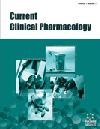- Home
- A-Z Publications
- Current Clinical Pharmacology
- Previous Issues
- Volume 11, Issue 1, 2016
Current Clinical Pharmacology - Volume 11, Issue 1, 2016
Volume 11, Issue 1, 2016
-
-
Anaesthesia in Cancer Surgery: Can it Affect Cancer Survival?
More LessSurgical removal of a tumor may, ironically, unleash prometastatic effects that enhance cancer recurrence and metastatic disease. The patient’s physiologic response to the surgical trauma may increase tumor cell growth and invasiveness while diminishing the immune system’s ability to eliminate residual disease. At the same time anaesthetic drugs used to accomplish the surgery may also have important effects on canc Read More
-
-
-
Binding of Cimetidine to Balb/C Mouse Liver Catalase; Kinetics and Conformational Studies
More LessCatalase is responsible for converting hydrogen peroxide (H2O2) into water and oxygen in cells. This enzyme has high affinity for hydrogen peroxide and can protect the cells from oxidative stress damage. Catalase is a tetramer protein and each monomer contains a heme group. Cimetidine is a histamine H2 receptor blocker which inhibits acid release from stomach and is used for gasterointestinal diseases. In this Read More
-
-
-
Microparticles: A Pivotal Nexus in Vascular Homeostasis and Disease
More LessMicrovesicles (MVs) are submicron intact particles released from the cellular membrane of eukaryotic cells. MVs can be sub-categorised into microparticles (MPs), which are between 100nm- 1micron in size, and exosomes, measuring less than 100nm. Once thought to be cellular debris, MPs are now known to play important biological effector functions. Their biogenesis and release are as a result highly regulated process Read More
-
-
-
Oral Administration of Sustained Release Niacin Inhibits Platelet Aggregation
More LessAuthors: Nicholas B. Norgard, Nicholas R. Bacon and Matthew AgostiBackground: Previous studies have suggested that niacin may have antiplatelet properties, however the effects of niacin on the platelet activity are not well defined. Objective: The purpose of this trial was to investigate whether the oral administration of niacin inhibits platelet aggregation. Method: This study was run in three segments measuring the inhibitory effect of niacin: 1) 3 mmol/L niacin in vitro, 2) one hour after 1-g Read More
-
-
-
Application of Organ Clearance to Estimation of the In Vivo Hepatic Extraction Ratio
More LessBy Reza MehvarOrgan clearance, which has been derived from the organ blood flow and extraction ratio (E), has been extensively used by clinical pharmacologists to explain the pharmacokinetics of many drugs in health and disease. For example, the extent of hepatic clearance or E (Eh) of drugs would determine their response to changes in the liver blood flow and/or activities of the metabolizing enzymes. Although Eh may be obtained Read More
-
-
-
Pharmacokinetics of Budesonide Administered with Surfactant in Premature Lambs: Implications for Neonatal Clinical Trials
More LessBronchopulmonary dysplasia (BPD) is a chronic lung disease of premature human infants, which may persist through adulthood. Airway inflammation has been firmly established in the pathogenesis of BPD. Previous studies to reduce airway inflammation with high-dose dexamethasone demonstrated adverse neurological outcomes, despite lower incidences of BPD. Instillation of budesonide and surfactan Read More
-
-
-
Association of Genetic Polymorphisms of CYP2C9 and VKORC1 with Bleeding Following Warfarin: A Case-Control Study
More LessIntroduction: Various factors have been shown to increase the risk of bleeding with warfarin. This study aimed to assess the association of CYP2C9 and VKORC1 with the development of bleeding following warfarin. Study Methods: A case control study was initiated after obtaining institutional ethics committee clearance and written informed consent from patients. Cases were defined as those who bled within three months of Read More
-
-
-
Conventional and New Antiepileptic Drugs on Vitamin D and Bone Health: What We Know to Date?
More LessThe treatment with antiepileptic drugs (AEDs), in particular conventional drugs, induces an increased risk of fractures in women and in epileptic patients in treatment with AEDs for more than 12 years. A supplementation with calcium and vitamin D is suggested in patients chronically treated with some AEDs and there are recommendations to do so. The lack of significant conclusive evidence about the effects of conventional Read More
-
Volumes & issues
Most Read This Month
Article
content/journals/ccp
Journal
10
5
false
en


